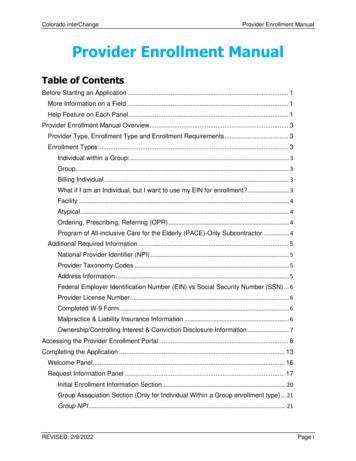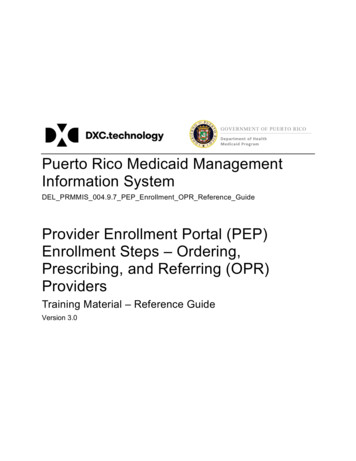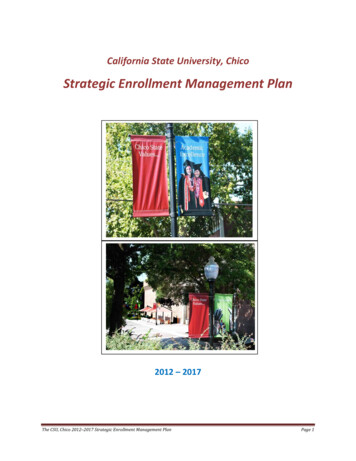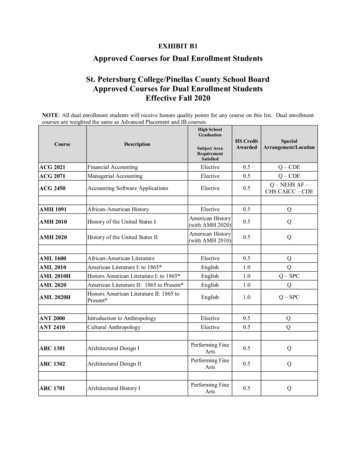
Transcription
DEnrollment Management Plan2010-2012AVC’s NicheAVC is a provider of convenient, affordable, comprehensive transfer, technical, vocational, andbasic skills instruction.Enrollment Management Mission:The Enrollment Management Committee as a body develops goals, sets directions, evaluatesstrategies and makes recommendations to shape the enrollment and to meet the stated missionand established institutional goals at Antelope Valley College.Strategic Goals from the Educational Master Plan that Relate to Enrollment Management Ensure a diverse managed enrollment by placing students first in designing anddelivering student-friendly programs and services.Develop a campus culture with a sense of community and a commitment to excellence.Improve the utilization of new and existing resources to support learning outcomes bystrengthening organizational effectiveness though research, planning, and the sharedgovernance processes.Achieve and maintain 1,000 FTES at the Palmdale Center.Results of the Environmental Scan 2010The Southern California Association of Governments projects tremendous growth in the areas ofLancaster and Palmdale; both are projected to surpass the 200,000 population mark by the year2020. Palmdale, the location of the Education Center, is projected to grow at a more rapid ratethan Lancaster. The entire district, which had a population in the year 2000 of 277,702, isprojected to grow to 460,000 by the year 2020. As the population is growing, it is also becomingfar more ethnically diverse. The Antelope Valley continues to be an area rich in leading-edgeaerospace research and manufacturing, but the working population also has developed a large(over 50,000 a day) commuter population. Antelope Valley College is also changing with agrowing student body with rapid decreases in age and increases in ethnic diversity.The college district includes 40% of the land mass of Los Angeles County, as well as a smallsection in the southeastern part of Kern County. The geography is characterized by a broad flathigh desert valley that merges into the San Gabriel Mountains. These mountains serve as aphysical divider between the Antelope Valley and the Los Angeles Basin. Also, located betweenthe mountains and the flat high desert valley is the California Aqueduct, one of the main sourcesof water for Southern California. This aqueduct runs through nearly the entire District.
In the center of the District are the two cities of Lancaster and Palmdale that account for 84percent of the District’s population. The rest of the population is dispersed somewhat equallythroughout the region. The location of the current campus is in the center of the entire District,providing equal access to all the rural areas. The nearest community colleges in other districtsare at least 39 miles away, making commuting time to these locations approximately an hour inlength.Major residential centers in the valley include the incorporated cities of Lancaster and Palmdale,and the smaller communities of Quartz Hill, Antelope Acres, Rosamond, Littlerock, Pearblossom, Acton, Sun Village, and Lake Los Angeles.For the first half of the 20th century, the basic industry in Antelope Valley was agriculture but,bythe late 1950s, aircraft and aerospace industries began to dominate the economy. Theregion’s dry climate and high percentage of sunny days make it an ideal location for aircraftmanufacturing and testing.Figure 1. Antelope Valley College District BoundariesThe Antelope Valley Community College District has a service area of 1,945 square miles. TheState of California Master Plan for Higher Education indicates that a community college isprimarily oriented to the needs of the local community--a University of California campus isconsidered statewide and California State University campus regional. The local community hasbeen defined as an attendance area within approximately 30 to 40 driving minutes from the siteof the campus. The travel distance to the next nearest community college suggests that this “freeflow” will not pull a large percentage of students from the District. However, this issue remainsbecause a large number of residents commute these distances for other reasons (job, shopping,etc.) and may find it convenient to take classes at a college near their destination outside theservice area.
The Palmdale Center Service AreaServices to south Antelope Valley have been expanded by the establishment of the PalmdaleCenter. The planning began in 1988 as the College began looking for a second campus site inthe southeast area of the District. A prospective site has been identified. The location is ideallysuited to respond to the actual and projected growth along the Highway 138 corridor.Regional approval for a center had been granted in 2009 yet justification for construction neededto be met by demonstrating an enrollment of 1000 sustainable Full-Time Equivalent Students(FTES) per academic year. An interim Palmdale Site was established, and in 2004, the interimPalmdale Site was moved to a new larger location on Palmdale Boulevard in order to expandservices in the area and thus establish the 1000 sustainable FTES required by the state which wasaccomplished in spring, 2010.The Palmdale Center ContributionThe Antelope Valley College Catalog indicates that the primary mission of the District is “ toserve the community by placing student success and student–centered learning as our numberone priority through higher educational standards and innovative programs and services in aprofessional, team-driven environment.” To better accomplish this mission the District hasestablished the new educational center to meet increasing community needs. The PalmdaleCenter now contributes to this mission by providing increased access to educationalopportunities and services.In addition to the educational benefits associated with the Palmdale Center, there are recognizedeconomic benefits. Better educated citizens have the increased opportunity to obtain rewardingcareers. The campus will also generate new jobs through both the construction of the campusand then through the operation of the campus. The Palmdale Center has become another positiveinfluence on the local economy, increasing both revenue and employment.The current Palmdale site is 11 miles south of Antelope Valley College. The Palmdale site isonly 19 miles from Littlerock and 25 miles from the town of Pearblossom. There is a limitedCSU, Bakersfield branch currently located at AVC and a proposal is under review to expandservices by establishing a CSU campus in the area. Currently the nearest four-year university isCSU, Northridge, which is 58 miles from the proposed site.There has been a major shift in age at Antelope Valley College over the past five years and it isnot showing signs of slowing down yet. The average age in spring 2002 term has dropped from32.85 to 28.05, a decline of almost five years. The median age (the middle age if you line all thestudents up from youngest to oldest) has gone from 27 in spring of 2002 to 23 in spring of 2006.The mode (the most common value) has gone from 23 in 2002 to 19 in 2006.The trend is continuing, the mean age in fall 2006 was 26.89, the median is now 22 years old,and the mode is 18 years old. What that means is that the most common age on campus this fallis 18 and half of all students are now 22 or less. This is not your father’s AVC, literally.Using population projections, it is possible to extract data on the relative adult population (age 18to 64), the age group considered to be the college-aged population. This data, which underscores
previous information showing very substantial population growth for both Lancaster andPalmdale in college-aged populations. As a result, AVC can anticipate that growth in numbersof students from population increases could lead to significant increases in the number ofstudents. AVC needs to prepare for these increases to maintain continued success in serving thecommunity.Another way in which growth in enrollment might occur is if the participation rate (students per1,000 of adult population) were to increase as a function of the total number of persons enrolledin college. Additional findings demonstrate that when studying the population by age groupcategories, the community is trending toward a younger population while also becoming morediverse.Table1. Population Projections of the 18-64 Age Group in AVCCD (Department of Finance (DOF),2000 U.S. Census, 2005 U.S. Census update).20002005201020152020Rosamond 7499,307113,420127,342PalmdaleUnincorporatedLA 1325,724One method used by the California Postsecondary Commission to project enrollment identifiesparticipation rates of adults per 1,000 in the population (18 to 64 age group). The enrollment isdivided by the population and multiplied by 1,000 to obtain the rate. Using the year 2000 and2005 as a baseline, a new average participation rate was calculated and then applied to theDistrict’s population projections. The new participation rate was 65.5 students per thousand ofadult population.Four high schools provide the largest share of freshmen enrolling at AVC. Quartz Hill sends thehighest share, with Highland, Lancaster and Palmdale following in that order (2003-04 through2006-07). The numbers of high school graduates attending AVC has increased proportionate tothe growth in public school populations during this period.Growth of school populations is part of a larger phenomenon that has been called Tidal Wave II,referencing the earlier “tidal wave” in school enrollments in the 1960s. Currently, not only havecommunities on the perimeter of the Los Angeles Basin grown as a natural occurrence, butimmigration has increased population numbers as people seeking jobs have moved into the area.Because enrollment growth at AVC over the next decade is likely to be strongly affected byenrollment patterns in local schools, enrollment projections for the public schools are animportant source for planning data. Based on historical enrollments in public K-12 schools in theAntelope Valley Community College District and current demographic trends, enrollments atAVC are likely to increase through the planning period.Figure2. High School Graduation Projections (Source: California Department of Education,DOF)
Antelope Valley Union HS DistrictHS 201314201415Academic YearAntelope Valley Union HS DistrictAntelope Valley College is the primary receiving collegiate institution for all high schools in theAntelope Union High School District. It is the most accessible college for students fromRosamond High School in Southern Kern Unified School District as well. The data in Figure 3shows the share of high school students from local schools that enroll at AVC followinggraduation (yield).Figure3. High School Yield (Number of students enrolled within 1 year of graduation) AVC, Office ofInstitutional ResearchWhat High Schools AVC Freshman Come From400350Number of 007150100500Wm. J. Pete Knight HighVasquez HSUnknown high schoolTrona HSTehachapi HSRosamond HSRosamond Christian HSR. Rex Parris SchoolQuartz Hill HSParaclete HSPalmdale HSOut-of-state high schoolNorth Edwards ContMojave HSLos Angeles Co HSLittlerock HSLancaster High SchoolHighland HSForeign country high schoolDesert Winds HSDesert Sands Charter SchoolDesert HSDesert Christian School LancasBoron HSBethel Christian HSAntelope Valley HSAntelope Valley Christian HSAntelope Valley AdultHigh SchoolTable2. Enrollment Projections for AVCCD (Southern California Association of Governments; Kern Council ofGovernments; California Community College Research and Planning Unit,)
EnrollmentUsingDOF ProjectionsEnrollmentUsingActual Growth 119,349*Represents ActualA significant portion of the residents in Antelope Valley commute to the Los Angeles Basin forwork. In 2007, close to half of the working population in the valley commuted long distances towork.Table 3 Antelope Valley Commuters (2007)Work Commuter DestinationShare of All WorkersSanta Clarita Valley4.3%Central-Western Kern County0.5%San Fernando Valley9.1%Burbank-Glendale-Pasadena3.0%Downtown LA Region9.4%Greater Metro Region4.0%No Fixed Location3.0%TOTALS33.4%Share of imated le 3 shows the number of residents commuting to various locations for employment outsideof the valley. In 2007 the total number of employed residents was 116,700 residents with the61,700 commuters making up 53% of the total. Patterns in student gender, age, and ethnicityreflect a statewide trend toward growth in the number of females attending college as well asgrowth in the Hispanic population. Females account for 58.3% of the student population.Hispanics are projected to become the state’s largest minority group by this year, 2011. By fall2009, Hispanic students at AVC account for 24.2% of the student population. African-Americanstudents represent 16% of the student population. Statewide, enrollments for African-Americansare constant; however the Antelope Valley as a whole has seen an increase in the percentage ofHispanic and African American groups over the past decade. Younger students, particularlythose under 20, represent a substantial percentage of the student population at this point in time.Patterns in student gender, age, and ethnicity observed in the district as a whole, are even morepronounced in the student population attending classes at the Palmdale site. The percentage offemale students is higher at Palmdale than in the district (68.8% vs. 61.4%). The percentage ofHispanic students is also higher at Palmdale than at the district as a whole (39.9% vs. 28.6%).The number of black students is also higher, though the difference is not as pronounced (25.4%vs. 19.2%).Planning Considerations
Planning enrollment for the Antelope Valley Community College District, and the new Palmdalecampus in particular, should take into account population projections that forecast approximately200,000 residents in both Lancaster and Palmdale by midyear 2015. Another important planningprovision is the relatively short distance between the two cities. Enrollment plans must bedeveloped to insure that demand for course offerings in Palmdale will not draw students awayfrom the Lancaster campus.The service area of the college is 1,945 square miles, and rural, but 84 percent of studentsattending are located in the cities of Lancaster and Palmdale. Both Palmdale and Lancaster areexperiencing population growth, with Palmdale slightly exceeding Lancaster at an averageannual growth of 3.21 percent compared to Lancaster’s 2.59 percent. Approximately 75,000people residing in Palmdale are in the 18 to 64 age group, the range most likely to attend acommunity college. The ethnic make-up of the two cities is similar, with Caucasians constitutinga slight majority, followed by Hispanics, and next, by African-Americans.Enrollment management over the next 3 to 5 years will account for the changes in demographicsdescribed in the previous section. Student needs will shift, both in terms of courses desired, andservices needed as we continue the three main trends: growth in the size of the student body,increasing ethnic diversity, a continuation of the shift towards a younger population, andsuccessfully supporting students in light of increasing budget constraints and fiscal reductions.To track these changes and to provide data for making sound policy decisions EnrollmentManagement plans the following steps: Focus groups of students, staff, and community members in the Palmdale site area and in themain AVC area to identify general issues relating to the Palmdale site; Surveys of the community at large to determine specific questions on classes and scheduling,potential demand for two 8-week classes per 16-week term, proportion of night and eveningclasses; Development of a model to statistically predict enrollment and FTES for future terms basedon class offerings; Standardization of efficiency measures for optimization of campus resources; Implementation of Astra Schedule room scheduling software to help in maximizing use ofcampus space and; Statistical modeling of student retention so that efforts can be made to target and help retainstudents at risk of dropping out after the fall term each year.Planning Process
The Enrollment Management Committee, a shared governance committee, reviews the AVCEducation Master Plan Strategic Goals and the Enrollment Management Performance Indicatorsin conjunction with the Institutional Learning Outcomes to determine the strategic goals for theacademic year. This Enrollment Management (EM) plan covers the academic years of 20102011 and 2011-2012 in order to reconnect the planning process with the Strategic Planning andBudget Committee (SPBC) planning and budget cycle.Representatives on this committee are responsible for sharing the process as well as the goals ofthe Enrollment Management (EM) plan with their constituents. Additionally, the plan, planningdocuments, supporting data and other materials can be accessed on the Enrollment Managementpage of the myAVC website.FallOnce the annual strategic goals are set and reviewed by the campus as a whole, the EnrollmentManagement Committee puts out a campus wide call for action plans in the fall semester intandem with the SPBC. Action plans based on the SEM are submitted to the EnrollmentManagement Committee which reviews the plans by means of utilizing a specific sub-group forone or more goals. For example, one sub-group might review action plans for goals one and twoand another for goals three and four. The number of sub-groups will depend upon the number ofgoals identified that planning cycle. The sub-groups will make recommendations to theEnrollment Management Committee concerning which plans should be supported as all of theplans are then submitted to SPBC and enter the regular process, including submission to theSPBC Budget Task Force.SpringDuring the spring semester, Enrollment Management monitors the progress of the plans andrequires an achievement report be submitted to the group by April of each year by the personsidentified in the plan as holding the accountability so that the committee may produce anAchievement Report by May of each year.
Enrollment Management Goals for 2010-2012In light of recent college and State budget considerations, the Enrollment ManagementCommittee is cognizant that absolute budget numbers for the foreseeable future will not beavailable. Therefore our focus for the next two years is to achieve our three stated goals byclosely monitoring resources and making essential adjustments during the year to assure theircompletion.Goal 1The Enrollment Management Committee will continue to support 1000 sustainableFTES at the Palmdale Center.Goal 2Planning efforts will continue to monitor/address shifts in workload directions from theChancellor’s office.Goal 3Meet base funding level per the Chancellor’s office.
Enrollment Management Mission: The Enrollment Management Committee as a body develops goals, sets directions, evaluates strategies and makes recommendations to shape the enrollment and to meet the stated mission and established institutional goals at Antelope Valley College. Strategic Goals from the Educational Master Plan that Relate to .










